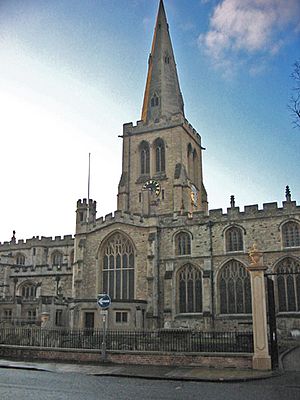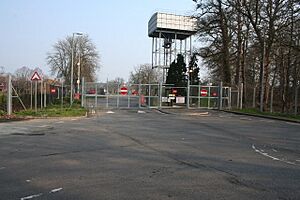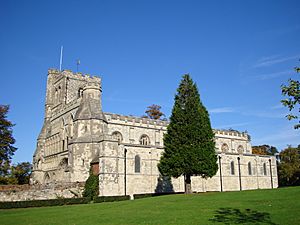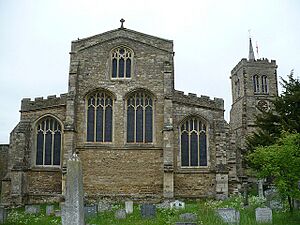List of monastic houses in Bedfordshire facts for kids
This article is about the old monastic houses in Bedfordshire, England. These were special places where groups of religious people, like monks, nuns, or friars, lived and worked together. They followed strict rules and dedicated their lives to prayer and study.
Some of these places were called alien houses. This means they belonged to a larger monastery in another country, usually France. Smaller places like cells (tiny monasteries) and granges (farmhouses with monks) are also included. We'll also look at places run by military orders, like the Knights Templars and Knights Hospitaller, who were both monks and soldiers.
We won't include regular hospitals here, unless they were also a type of abbey, priory, friary, or preceptory.
Contents
- What are Monastic Houses?
- Monastic Houses in Bedfordshire
- Beadlow Priory
- Bedford Greyfriars
- Bedford Abbey
- Bedford Priory
- Bushmead Priory
- Caldwell Priory
- Chicksands Priory
- Dunstable Blackfriars
- Dunstable Priory
- Elstow Abbey
- Grovebury Priory
- Hardwick Preceptory
- Harrold Priory
- Harrold Priory Cell
- Leighton Buzzard Cell
- Melchbourne Preceptory
- Millbrook Priory
- Newnham Priory
- Pulloxhill Grange
- Ruxox Cell
- Turvey Abbey
- Turvey Monastery
- Warden Abbey
- Woburn Abbey
- See also
What are Monastic Houses?
Monastic houses were communities where people lived a religious life. Monks and nuns lived in abbeys and priories. Friars lived in friaries. These places were very important in medieval England. They were centers for learning, farming, and helping the poor.
Most of these houses were closed down in the 1530s by King Henry VIII. This event is known as the Dissolution of the Monasteries. Many buildings were destroyed, but some parts still stand today.
Monastic Houses in Bedfordshire
Beadlow Priory
Beadlow Priory was home to Benedictine monks. They came from a larger monastery in St Albans, Hertfordshire. Henry d'Albini founded it between 1140 and 1146. The priory was dedicated to Saint Mary Magdalen. The monks left in 1435, and the buildings slowly fell apart.
Bedford Greyfriars
The Franciscan Friars Minor lived at Bedford Greyfriars. They were also known as Greyfriars because of their grey robes. Mabilea de Plateshull founded this friary in 1238. It was closed around 1539.
Bedford Abbey
Bedford Abbey was an early home for Benedictine monks. It was founded before 971. Sadly, it stopped existing many years before 1066. It might have been destroyed during raids by the Danes in 1010.
Bedford Priory
Bedford Priory started as a college for secular canons before 1066. Later, around 1165, it became home to Augustinian Canons Regular. The community moved to a new site at Newnham around 1080. Today, the parish church of St Paul stands on the old site.
Bushmead Priory
Bushmead Priory housed Augustinian Canons Regular. Hugh Beauchamp founded it in 1195. It was dedicated to Saint Mary. The priory was closed in 1536. Today, the old refectory (dining hall) is part of a mansion built on the site. English Heritage looks after it.
Caldwell Priory
Augustinian Canons Regular lived at Caldwell Priory. It was founded around 1154, possibly by Simon Basket. The priory was dedicated to Saint John the Baptist. It was closed in 1536.
Chicksands Priory
Chicksands Priory was a special "double house" for both Gilbertine Canons and Canonesses. This means both monks and nuns lived there, but in separate areas. Pain de Beauchamp and his wife Rose founded it around 1150. The priory was dedicated to Saint Mary. It closed in 1538. Parts of the old cloisters (covered walkways) are now part of a private house. The site was later used as a military base.
Dunstable Blackfriars
The Dominican Friars, also known as Blackfriars, lived at Dunstable Blackfriars. They were invited by King Henry III and his wife in 1259. The friary was closed before May 1539.
Dunstable Priory
Dunstable Priory was home to Augustinian Canons Regular. King Henry I founded it in 1131. The priory was dedicated to Saint Peter. It was closed in 1540. The nave (main part) of the church is still used as a local parish church today.
Elstow Abbey
Elstow Abbey was a community of Benedictine nuns. Judith, who was the niece of William the Conqueror, founded it in 1078. The abbey was dedicated to Saint Mary and Saint Helena. It was closed in 1539. Like Dunstable, the nave of the abbey church is now used as a parish church.
Grovebury Priory
Grovebury Priory in Leighton Buzzard was an alien house for Fontévrault Benedictine monks and nuns. It was a "double house" like Chicksands, but it was dependent on Fontévrault Abbey in France. King Henry II granted the land after 1164. The priory was founded after 1189. It might never have been fully set up as a proper monastery, possibly just a chapel. It was closed in 1414. A farmhouse was later built on the site.
Hardwick Preceptory
Hardwick Preceptory was a base for the Knights Hospitaller. These were military monks who cared for pilgrims and the sick. It was founded before 1279 and closed before 1489.
Harrold Priory
Harrold Priory was home to Augustinian Canonesses. Sampson le Forte founded it in 1138. It was originally an alien house, connected to Arrouaise in Normandy, France. However, it became independent in 1188. The priory was dedicated to the Blessed Virgin Mary and Saint Peter. It was closed in 1536. Today, a farmhouse and a mansion called 'Harrold Hall' are on the site.
Harrold Priory Cell
A small cell for Augustinian Canons Regular was attached to Harrold Priory. It was founded around 1136-1138 and closed before 1181.
Leighton Buzzard Cell
This was a small cell or grange for Cistercian monks. It was dependent on Woburn Abbey. It was founded before 1159.
Melchbourne Preceptory
Melchbourne Preceptory was another base for the Knights Hospitaller. Lady Alice de Claremonte founded it before 1176. It was closed in 1486. The Knights Hospitaller briefly got it back under Queen Mary.
Millbrook Priory
Millbrook Priory was a small priory cell for Benedictine monks. It was dependent on St Albans Abbey. The church was granted to St Albans between 1097 and 1119. It was later merged with Beadlow Priory around 1143.
Newnham Priory
Newnham Priory was home to Augustinian Canons Regular. The community originally started at Bedford Priory around 1165. They moved to Newnham around 1180. The priory was dedicated to Saint Paul. It was closed in 1540.
Pulloxhill Grange
Pulloxhill Grange was a farm belonging to Dunstable Priory. It was run by Augustinian Canons Regular. After the Dissolution, it was granted to Sir William Pagett in 1547.
Ruxox Cell
Ruxox Cell was a small cell or chapel for retired Augustinian Canons Regular from Dunstable Priory. It was founded before 1189 and closed after 1290. The chapel was dedicated to Saint Nicholas.
Turvey Abbey
Turvey Abbey is unique because it is still active today! It is home to Benedictine nuns. It is next to a Benedictine monastery.
Turvey Monastery
Turvey monastery is a modern monastery for Benedictine monks. It was founded in 1980 and is still active. It is located next to Turvey Abbey.
Warden Abbey
Warden Abbey was a large abbey for Cistercian monks. Walter Espec founded it in 1136. It was dedicated to the Blessed Virgin Mary. The abbey was closed on December 4, 1538. An Elizabethan house was later built on the site, and some parts of it still remain. The Landmark Trust renovated it in 1974.
Woburn Abbey
Woburn Abbey was another important abbey for Cistercian monks. It was a "daughter house" of Fountains Abbey in Yorkshire, meaning it was founded by monks from Fountains. Hugh de Bolebec founded it on May 28, 1145. The abbey was dedicated to the Blessed Virgin Mary. It was closed in 1538. Today, a large mansion, estate, and safari park are on the site.
See also







